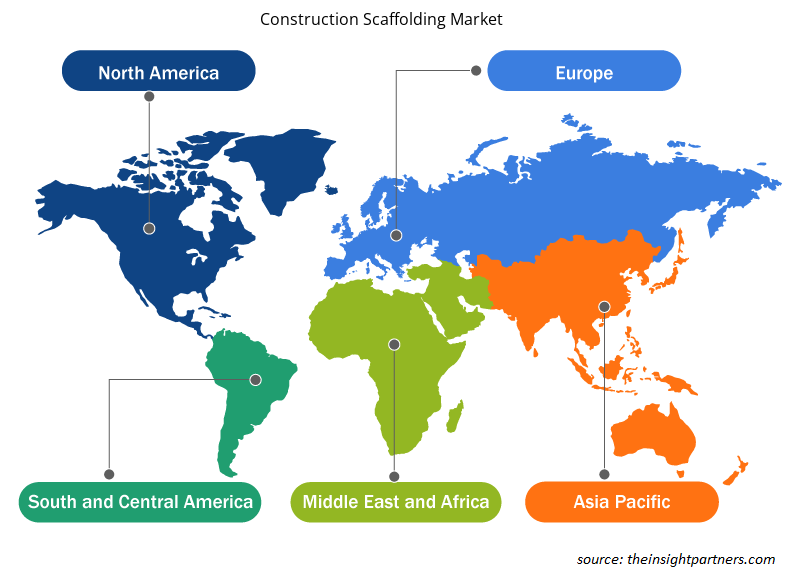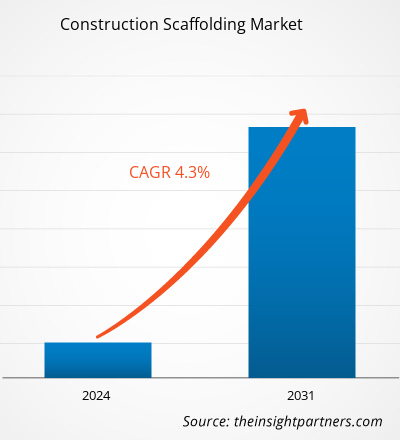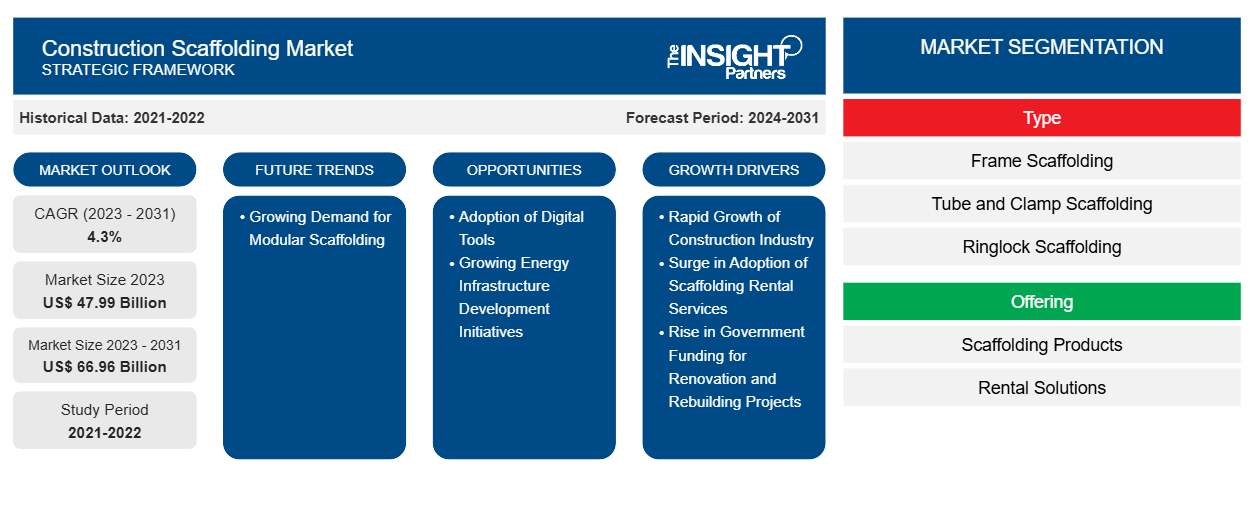建設用足場の市場規模は、2023 年の 479.9 億米ドルから 2031 年には 669.6 億米ドルに達すると予測されています。市場は 2023 年から 2031 年にかけて 4.3% の CAGR を記録すると予想されています。モジュラー足場の需要の高まりにより、今後数年間で市場に新たな主要トレンドがもたらされる可能性があります。
建設足場市場分析
2023年に世界銀行が発表したデータによると、2022年の総人口の約56%にあたる44億人が都市部に居住しており、2010年には35億人が都市部に住んでいると登録されていました。さらに、各国の政府によるインフラの改善と開発に向けたさまざまな取り組みが続けられており、それが足場の需要増加につながっています。例えば、インド政府は2015年にすべての人に手頃な価格の住宅を提供する計画を導入し、この計画を通じて2019年から2024年の間に約1,000万戸の住宅が建設されました。2016年、サウジアラビア政府はサウジアラビア2030計画を発表し、2024年に住宅、商業、公共インフラの開発に約1.3兆米ドルを投資しました。このような高層ビル建設の増加により、安全で効果的な建築資材の必要性が大幅に高まり、最終的に足場の需要を押し上げました。このように、建設業界の急速な成長が足場市場を牽引しています。
デジタル化は業界全体で顕著に進んでいますが、特に建設業界において顕著です。一般的に使用されているデジタルツールの 1 つがビルディング インフォメーション モデリング (BIM) です。BIM を使用すると、ユーザーは建設や足場の仮想 3D モデルを作成できます。したがって、先進国と発展途上国のメーカーや建設会社によるデジタルツールの採用は、予測期間中に足場市場の成長に有利な機会を生み出すと予想されます。
建設足場市場の概要
住宅や商業施設の建設に対する需要の増加は、世界中で足場の需要を牽引している要因の1つです。さらに、改修や改造活動への支出の増加も、建設用足場市場の成長にプラスの影響を与えているもう1つの要因です。歴史的建造物の改修には、元の特徴を維持するための繊細な作業が必要です。足場は、建物の完全性を損なうことなく、安全で最小限の侵襲で修復およびメンテナンスを行う方法を提供します。たとえば、2023年8月、T&T Construction Enterprisesは、米国に拠点を置くハーディン郡公立図書館の改修工事で366万米ドル相当の契約を獲得しました。このようなプロジェクトにより、予測期間中に建設用足場の需要が増加すると予想されます。
要件に合わせてレポートをカスタマイズする
このレポートの一部、国レベルの分析、Excelデータパックなど、あらゆるレポートを無料でカスタマイズできます。また、スタートアップや大学向けのお得なオファーや割引もご利用いただけます。
- このレポートの主要な市場動向を入手してください。この無料サンプルには、市場動向から見積もりや予測に至るまでのデータ分析が含まれます。
建設足場市場の推進要因と機会
足場レンタルサービスの導入急増
初期投資は、建設業界においてプロジェクトや会社の全体的な収益性に影響を与える可能性のある主要な要因の 1 つです。足場レンタルは、先行投資の必要がなくなるため、ほとんどの中小規模の建設会社や請負業者にとって柔軟で費用対効果の高いオプションです。これにより、企業や請負業者は中小規模のプロジェクトで利益を増やすことができます。さらに、近代的な建設の需要が高まるにつれて、さまざまなタイプやサイズの足場に対する要件も高まり、複雑さも増しています。さまざまな種類の足場を購入する企業や請負業者は、全体的な運用コストの増加に直面します。さらに、プロジェクトが完了すると、足場を適切な施設に保管する必要があり、追加の費用が発生します。レンタル サービスは、特定のプロジェクトのニーズに最も適した足場システムを柔軟に選択できるようにします。建設業界とは別に、エンターテイメントおよび映画制作部門では、季節的に足場の需要があります。足場レンタル会社を利用すると、エンドユーザーは必要なときにいつでもさまざまな種類の足場を利用できるため、長期保管や初期投資の必要性が減ります。このような柔軟性と運用コストの削減、そして建設業界の成長により、ここ数年で足場レンタルの需要と採用が増加しています。そのため、足場レンタルサービスの採用の急増が市場を牽引しています。
スマートシティ構想とインフラ開発プロジェクトの増加
建設と足場の 3D モデリングにより、請負業者と建設会社は、足場の種類を含む必要な資材を正確に計画できるようになり、設計のエラーを減らすことができます。これにより、リソースを効果的かつ効率的に使用でき、最終的には運用コストを削減できます。さらに、デジタル ツールはデータ分析と洞察を提供し、足場プロバイダーが在庫管理、リソース割り当て、プロジェクト スケジューリングを最適化するのに役立ちます。デジタル ツールと自動化を活用することで、足場メーカーとプロバイダーは、運用を合理化し、安全性を高め、プロジェクト全体の効率を向上させる高度なソリューションを提供できます。したがって、先進国と発展途上国のメーカーと建設会社によるデジタル ツールの採用は、予測期間中に足場市場の成長に有利な機会を生み出すと予想されます。
建設足場市場レポートのセグメンテーション分析
建設足場市場分析の導出に貢献した主要なセグメントは、タイプ、提供、およびアプリケーションです。
- タイプに基づいて、建設足場市場は、フレーム足場、チューブとクランプ足場、リングロック足場、カップロック足場、およびその他の従来の足場に分類されます。チューブとクランプ足場セグメントは、2023年に市場で最大のシェアを占めました。
- 用途別に見ると、建設用足場市場は、住宅、商業ビル、工業、石油・ガス産業、イベントに分類されます。2023年には、商業ビル部門が市場を支配しました。
- 提供内容から見ると、建設用足場市場は足場製品(販売)とレンタルソリューションに分かれています。2023年には、足場製品(販売)セグメントが市場で大きなシェアを占めました。
建設足場市場シェア分析
建設用足場市場レポートの地理的範囲は、詳細な国別分析を提供します。北米、ヨーロッパ、アジア太平洋は、足場市場で大幅な成長が見られる主要地域です。北米とヨーロッパには足場のメーカーやサプライヤーが数多く存在し、これらの地域の市場を牽引しています。たとえば、Atlantic Pacific Equipment LLC、PSB Scaffolding Group Ltd、Rotamead Ltd、Catari Industria SAは、北米とヨーロッパで活動する主要企業です。さらに、アジア太平洋諸国の建設部門の成長も、足場の需要を促進しています。2024年、NLEX Corporationはフィリピンで3つの新しいインフラ開発プロジェクトを発表しました。さらに、2024年にインドネシア政府は、住宅、商業、道路インフラの開発とアップグレードのコストを含む、264億8000万米ドルに達する国内最大のインフラ予算を発表しました。現在、アジア太平洋地域では425件のうち約155件の空港および空港インフラ開発プロジェクトが開発中であり、投資額は2,090億米ドルに上ります。たとえば、アジア太平洋地域で最大の空港開発プロジェクトの1つはベトナムのロンタン国際空港で、投資額は145億米ドルで、2025年までに完成する予定です。さらに、シンガポールのチャンギ空港ターミナル5の拡張は100億米ドルのプロジェクトで、2030年までに完成する予定です。インフラ開発に対する政府の重点の高まりも、アジア太平洋地域の足場市場にプラスの影響を与えています。
さまざまな最終用途におけるエネルギー、天然ガス、原油の需要拡大により、中東およびアフリカのエネルギー、電力、石油、ガスパイプライン インフラストラクチャの成長が促進され、足場の適用範囲が拡大しています。急速な都市化により住宅および商業インフラストラクチャの開発が促進され、建設機械の適用が促進され、中東およびアフリカの足場市場が成長しています。
建設用足場市場の地域別分析
予測期間を通じて建設足場市場に影響を与える地域的な傾向と要因は、Insight Partners のアナリストによって徹底的に説明されています。このセクションでは、北米、ヨーロッパ、アジア太平洋、中東、アフリカ、南米、中米にわたる建設足場市場のセグメントと地理についても説明します。

- 建設足場市場の地域別データを入手
建設足場市場レポートの範囲
| レポート属性 | 詳細 |
|---|---|
| 2023年の市場規模 | 479.9億米ドル |
| 2031年までの市場規模 | 669.6億米ドル |
| 世界のCAGR(2023年~2031年) | 4.3% |
| 履歴データ | 2021-2022 |
| 予測期間 | 2024-2031 |
| 対象セグメント | タイプ別
|
| 対象地域と国 | 北米
|
| 市場リーダーと主要企業プロフィール |
|
市場プレーヤーの密度:ビジネスダイナミクスへの影響を理解する
建設用足場市場は、消費者の嗜好の変化、技術の進歩、製品の利点に対する認識の高まりなどの要因により、エンドユーザーの需要が高まり、急速に成長しています。需要が高まるにつれて、企業は提供を拡大し、消費者のニーズを満たすために革新し、新たなトレンドを活用し、市場の成長をさらに促進しています。
市場プレーヤー密度とは、特定の市場または業界内で活動している企業または会社の分布を指します。これは、特定の市場スペースに、その市場規模または総市場価値に対してどれだけの競合相手 (市場プレーヤー) が存在するかを示します。
建設足場市場で事業を展開している主要企業は次のとおりです。
- PERI GmbH
- ドカ株式会社
- レイハーNA
- ULMAグループ
- アルフィックス
- アルトラッドグループ
免責事項:上記の企業は、特定の順序でランク付けされていません。

- 建設足場市場のトップキープレーヤーの概要を入手
建設足場市場のニュースと最近の動向
建設用足場市場は、主要な企業出版物、協会データ、データベースなどの一次調査と二次調査を経て定性的および定量的データを収集することで評価されます。建設用足場市場の動向のいくつかを以下に示します。
- ULMA Poland のエンジニアリング チームは、ワルシャワの中心部に位置するこの建物のコンクリート表面の最高品質を確保するために、型枠と足場の研究と適用に継続的に取り組んできました。特徴的なむき出しの白いコンクリート壁は内部空間と完璧に調和し、建物のボリュームは街の文化的環境に溶け込んでいます。(出典: ULMA、プレス リリース、2023 年 10 月)
- レイハーは、ボルチモア郡に足場の配送とサポート業務のための建物を取得しました。施設の立地特性により、エンジニアリング業務、組み立て、保管、オフィススペースに多くの機会が与えられました。さらに、移転により、同社はボルチモアに留まり、コミュニティの一員となることができました。(出典: レイハー、プレスリリース、2023 年 1 月)
建設足場市場レポートの対象範囲と成果物
「建設足場市場の規模と予測(2021〜2031年)」レポートでは、以下の分野をカバーする市場の詳細な分析を提供しています。
- 対象範囲に含まれるすべての主要市場セグメントの国レベルでの建設足場市場規模と予測
- 建設用足場市場の動向、および推進要因、制約、主要な機会などの市場動向
- 詳細なPESTおよびSWOT分析
- 主要な市場動向、国の枠組み、主要プレーヤー、規制、最近の市場動向を網羅した建設足場市場分析
- 建設用足場市場の市場集中、ヒートマップ分析、主要プレーヤー、最近の動向を網羅した業界の状況と競争分析
- 詳細な企業プロフィール
- 過去2年間の分析、基準年、CAGRによる予測(7年間)
- PEST分析とSWOT分析
- 市場規模価値/数量 - 世界、地域、国
- 業界と競争環境
- Excel データセット
最新レポート
お客様の声
購入理由
- 情報に基づいた意思決定
- 市場動向の理解
- 競合分析
- 顧客インサイト
- 市場予測
- リスク軽減
- 戦略計画
- 投資の正当性
- 新興市場の特定
- マーケティング戦略の強化
- 業務効率の向上
- 規制動向への対応





















 無料サンプルを入手 - 建設足場市場
無料サンプルを入手 - 建設足場市場